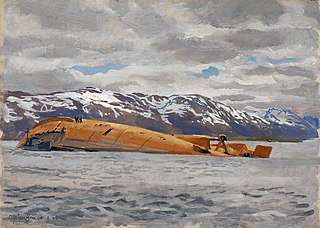Related Research Articles

Operation Sportpalast, also known as Operation Nordmeer, was a German naval raid between 6 and 13 March 1942 against two of the Allied Arctic convoys of World War II as they passed through the Norwegian Sea. It was conducted by the battleship Tirpitz, three destroyers and eight submarines. The German ships were unable to locate either of the convoys but sank a merchant vessel that was sailing independently. The Allies attempted to intercept the German force, also without success.

Operation Tungsten was a Second World War Royal Navy air raid that targeted the German battleship Tirpitz. The operation sought to damage or destroy Tirpitz at her base in Kaafjord in the far north of Norway before she could become fully operational again following a period of repairs.

Torstein Pettersen Raaby was a Norwegian telegrapher, resistance fighter and explorer. He is known as a crew member on the Kon-Tiki expedition.

Knut Magne Haugland, DSO, MM, was a resistance fighter and noted explorer from Norway, who accompanied Thor Heyerdahl on his famous 1947 Kon-Tiki expedition.

Hugo Conrad Munthe-Kaas DSM was a Norwegian intelligence agent and resistance fighter during World War II. He received seventeen decorations for his war service. From the 1970s he was active in the Progress Party, where he was a city council member in Oslo and deputy MP. He was an honorary party member.

Operation Paravane was a British air raid of World War II that inflicted heavy damage on the German battleship Tirpitz, at anchor in Kaafjord in the far north of German-occupied Norway. The attack was conducted on 15 September 1944 by 21 Royal Air Force heavy bombers, which flew from an airfield in the north of the Soviet Union. The battleship was struck by one bomb, and further damaged by several near misses. This damage rendered Tirpitz unfit for combat, and she could not be repaired as it was no longer possible for the Germans to sail her to a major port.

Operation Obviate was an unsuccessful British air raid of World War II which targeted the German battleship Tirpitz. It was conducted by Royal Air Force heavy bombers on 29 October 1944, and sought to destroy the damaged battleship after she moved to a new anchorage near Tromsø in northern Norway.

Operation Catechism was a British air raid of World War II that destroyed the German battleship Tirpitz. It was conducted on 12 November 1944 by 29 Royal Air Force heavy bombers that attacked the battleship at its anchorage near the Norwegian city of Tromsø. The ship capsized after being hit by at least two bombs and damaged by the explosions of others, killing between 940 and 1,204 members of the crew; the British suffered no casualties.
Hjelm Waage Thurn-Basberg was a Norwegian resistance member during World War II. He fled Norway twice due to his resistance to the German occupation, but returned both times to work with intelligence for the British Secret Intelligence Service (MI6).
Erik August Lindhè Welle-Strand was a Norwegian mining engineer and resistance member during World War II. He is best known as leader of the illegal radio post Skylark B.
Sverre Midtskau was a Norwegian resistance member during World War II. He is best known as leader of the illegal radio post Skylark A.
Oliver (Einar) Johansen was a Norwegian engineer and resistance member during World War II. He is known as a member of the illegal radio group Skylark B, and after this was discontinued he set up new radio posts in Tromsø and the rest of Northern Norway. He was highly decorated.
Bjørn Arnold Rørholt was a Norwegian engineer, military officer, Secret Intelligence Service agent and resistance member during World War II.
Bjarne Winter Thorsen was a Norwegian resistance member during World War II and later a naval officer.
"Theta" was a radio communications group that operated in Bergen, Norway during the German occupation of Norway, communicating with the British Secret Intelligence Service (SIS). The group was operative from December 1941 to June 1942.

Oluf Bernhard Reed-Olsen was a Norwegian resistance member and pilot during World War II. As a resistance member he is best known for the Lysaker Bridge sabotage as well as operating illegal radio transmitters. After the war he was a businessman and Scouting leader. He wrote books and contributed to a film based on his war experience.

Tirpitz Museum is a war museum that is located in Kåfjord outside the city of Alta in Troms og Finnmark county, Norway.

Tirpitz was the second of two Bismarck-class battleships built for Nazi Germany's Kriegsmarine (navy) prior to and during the Second World War. Named after Grand Admiral Alfred von Tirpitz, the architect of the Kaiserliche Marine, the ship was laid down at the Kriegsmarinewerft in Wilhelmshaven in November 1936 and her hull was launched two and a half years later. Work was completed in February 1941, when she was commissioned into the German fleet. Like her sister ship, Bismarck, Tirpitz was armed with a main battery of eight 38-centimetre (15 in) guns in four twin turrets. After a series of wartime modifications she was 2000 tonnes heavier than Bismarck, making her the heaviest battleship ever built by a European navy.

Operation Mascot was an unsuccessful British carrier air raid conducted against the German battleship Tirpitz at her anchorage in Kaafjord, Norway, on 17 July 1944. The attack was one of a series of strikes against the battleship launched from aircraft carriers between April and August 1944, and was initiated after Allied intelligence determined that the damage inflicted during the Operation Tungsten raid on 3 April had been repaired.
References
- 1 2 3 4 5 6 Bratli, Kjell Arne (12 October 1989). "Knut Moe (obituary)". Aftenposten (in Norwegian). p. 15.
- 1 2 3 4 Rørholt, Bjørn (30 April 1998). "Med radio som våpen mot tysk krigsmakt". Aftenposten (in Norwegian). p. 25.